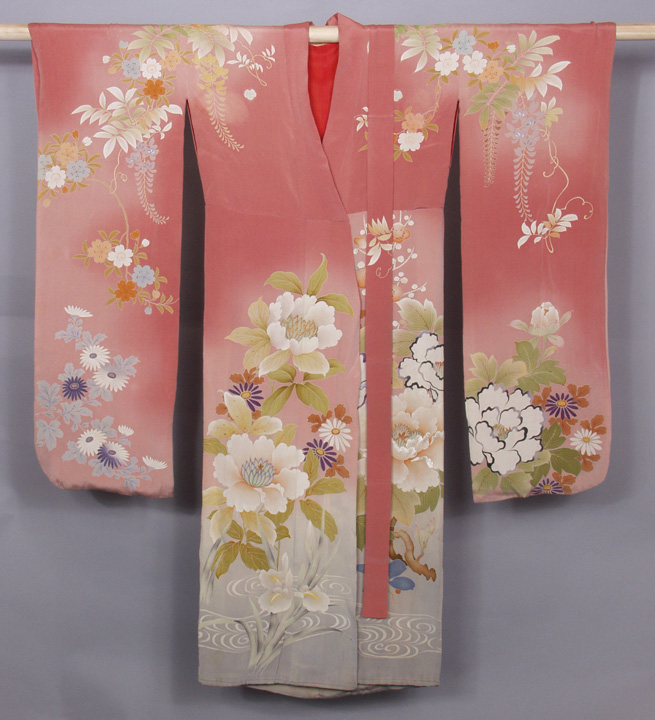
Kimono, silk, 51 x 48 in., Scripps College, Claremont, CA
This floral, silken kimono was likely created as a dressing gown for women in the West, where there was a taste for Japanese art and culture. The flat, planar design of kimono corresponded to a growing interest in abstract art. Women wore them beginning in the late 19th century as an alternative to constricting corsets and other structured clothing, for kimonos were not intended to be fitted to the body. This robe recalls a long tradition of Japanese dress which piqued the interest of the Western market, demonstrating cross-cultural interactions that manifest on the body.
This style, called a furisode, emerged in the mid-16th century as upper-class children’s clothing. At that time, boys and girls both wore this type of kimono: in fact, three hundred years would pass before fabric designs denoted gender. That change came with the influx of Western culture after the Second World War. As it became linked with women’s clothing, the children’s garment acquired the name wakaike, referring to the open edges of the sleeves. Over time, the furisode and wakaike evolved and the former became associated with more elegant dress. A woman would wear a furisode until she reached adulthood or was married. Boys also wore this style of garment until the age of 18, when they were recognized as adults.
Created in the mid-20th century, this kimono features a pink background with stenciled flowers, ferns, and water on silk crepe. While the exterior is in soft pastel colors, the interior lining opens to reveal a vibrant red. This style was typical of 1950s kimonos, which were often decorated with floral designs with a red lining, and were worn by young, unmarried women on formal occasions. The light color indicates that it was intended for a younger woman; darker colors would have been worn by older women. The garment might have been worn to a coming-of age-ceremony, a tea ceremony, a relative’s wedding, or to vote, a right granted to Japanese women in 1945.
This particular kimono is constructed with silk crepe, which is typical of furisode. The designs are stenciled onto the fabric by employing the yuzen technique, a method of resist-dyeing using rice paste. To create these complex pictorial elements, an artisan applies the paste, allows it to dry, then adds multi-colored dyes free-handed with a fine brush. This technique became popular at the end of the 17th century, during the Edo period. The subtle gradations in color allow for pictorial designs of maple leaves, flowers, and grasses. The flowers on this garment could be lotuses or chrysanthemums. The water depicted at the bottom of the kimono suggests that the flowers growing nearby are lotuses. However, lotus petals are typically smooth, while these are jagged like those typical of Japanese chrysanthemums, posing challenges for a definitive identification.
Marielle Epstein, Wilson intern, SC ’18
Works Consulted:
Dalby, Liza Crihfield. Kimono: Fashioning Culture. New Haven, Conn., Yale University Press, 1993.
Fujita, Taki. “Women and Politics in Japan.” The Annals of the American Academy of Political and Social Science, Vol. 375, 1968, pp. 91–95.
Fukatsu-Fukuoka, Yuko. “The Evolution of Yuzen-Dyeing Techniques and Designs after the Meiji Restoration.” 2004, digitalcommons.unl.edu/cgi/viewcontent.cgi?article=1474&context=tsaconf.
Kawlra, Aarti. “The Kimono Body.” Fashion Theory, vol. 6, no. 3, 2015, pp. 299–310.
“Kimono Dressing Gown.” FIDM Museum Blog, 18 Dec. 2009, blog.fidmmuseum.org/museum/2009/12/kimono-dressing-gown.html.
Ling, Yuki. “10 Different Types of Kimono for Women.” Tsunagu Japan, www.tsunagujapan.com/10-different-types-of-kimono-for-women/.
Oldham, C. Types of Japanese Kimonos, www.wafuku.co.uk/kimonoinfo12.htm.

